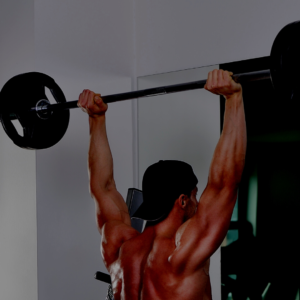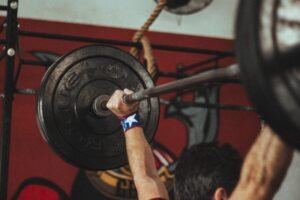Fix Your Fundamentals : Essential Lifts 101 – The Overhead Press
You stand straight up and press a barbell directly over your head. If you haven’t been lifting at all, it can invoke cartoonish images of carnival strongmen from olden times. If you’ve been in the gym but haven’t been using the overhead press, it can seem unneccesary – it’s often passed over for other versions of a shoulder press. But in doing so, it’s distinct and unique benefits are passed over as well.
history of the overhead press
Today, you expect to be asked about your bench before any other lift. But the overhead press was once the standard measure of strength, the clearest way to test yourself and show off your might. In the first half of the 1900s, the overhead press came up from traveling strongman competitions to being one of the three lifts in the Olympic games.
The beginning of the fall of the overhead press was the realization that it wasn’t great for competition. Competitors learned to use tricks such as leaning far backwards to lift heavier weights, essentially turning the lift into an incline press. After years of these types of shenanigans, the overhead press was removed from the Olympics after the 1972 games.
The timing of the removal coincided with the rise of powerlifting, which was already turning the focus of the weightlifting to the big 3 lifts of the bench press, squat and deadlift. The bench press became the absolute standard, in large part because of its simple, straightforward nature.
Around the same time, Arnold Schwartzenegger popularized a version of the seated dumbbell shoulder press, now known as the Arnold, and the overhead press continued to fade further into the background.
THE overhead PRESS
This lift is the single best exercise you can do to build your shoulders. Beyond that, it hits your upper chest, triceps, core, and to lesser degrees, your glutes, biceps, and lats.
The main focus is the anterior and lateral deltoids, or the muscles at the front and middle of your shoulders. Because you’re standing, your core and stabilizer muscles are working, and your back is helping to keep balance.
The overhead press also solves upper body deficiencies and imbalances that can help you break through plateaus elsewhere. Additionally, it’s functionally beneficial, useful for throwing sports and pushing activities.
(Note: The overhead press is sometimes interchangeably called the military press, but the military press is a specific variation executed with the feet together. We’ll go into that in our upcoming variations article.)

So let’s establish the basics of the barbell overhead press:
How To Overhead Press
FIRST, Set your base. Set up with a strong stance, feet shoulder-width apart and pointed forward or slightly out.
NEXT, Take the barbell in a shoulder-width grip, with the bar seated in the meaty heel of your palms, elbows directly under wrists in a straight line and tucked in, for greatest power and control.
(Lab tip: greater wrist mobility will lead to a stronger overhead press)
KEEP your gaze straight ahead. Keep your legs straight, and hips locked no bend at all.
SQUEEZE your shoulder blades together while keeping your chest up to use shoulders to intiate lift. Focus on keeping your shoulders doing the work. Inhale.
LIFT the bar in a vertical line, exhaling as you press, keeping your body as close to the bar as possible; your lean back should be almost imperceptible, just enough to not knock yourself out with the bar.
LOCK your elbows out at the top.

LOWER the bar under control to shoulder-level, as you inhale. Keep your forearms vertical, wrist-to-elbow.
NOW that you’ve nailed your first rep, keep going strong!
TIPS
Never change the vertical line of your lift to avoid your head. Use a subtle movement of your hips forward to let your head veer back. Press the weight vertically, straightening your posture as you reach the top of the lift.
Extend fully at the top – lock your elbows and then shrug your shoulders up. This shrug has been said to prevent shoulder impingement, which is related to various forms of shoulder pain.
What to avoid
Improper grip width
Probably the most common mistake, and a crucial mistake that can lead to all the rest of the issues we’ll go over, such as flared elbows.
Fix:
The easiest fix is to ensure your arms are vertical when you grip the barbell, and that your wrists and elbows are in a straight line. This is your most efficient and most powerful position.
Elbows flaring
This will put undue stress on your shoulders and elbows, risk injury, and you won’t be getting as much out of the lift.
Fix:
Ensure proper grip. If this is happening, chances are your grip is too wide.
Arching of the lower back
Fix:
Pressing at an angle instead of vertically
This often happens as a result of mobility issues. It puts the wrong kind of stress on your lower back, and can lead to overcompensating in ways that further the risk of injury
Fix:
Carefully go over each step in our guide. Core stability will help this one as well, but if the issue is mobility, it may be best to find a shoulder press variation that works better for you.
The Last Word
The standing barbell overhead press is easily the best lift for your shoulders, and it can fill an important role in all types of workout programs.
When strictly executed, the overhead press is one of the most beneficial compound lifts, and goes far beyond its core target to engage your entire body.
Keeping your form on point, and implementing this wisely can lead to serious gains, along with heightened balance and stability overall.


